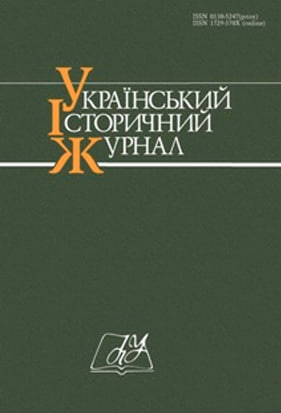RUTHENIAN NON-CROWNED SETTLERS IN THE LANDS OF THE PIASTS OF THE 11th — MID-14th CENTURIES: NAMING AND IDENTIFICATIONS
DOI:
https://doi.org/10.15407/uhj2025.01.007Keywords:
Rus, Lesser Poland, Greater Poland, Silesia, Mazovia, migrations, settlers, identification, prince, princess, non-crowned elitesAbstract
The purpose of the article is to systematize and classify all forms of recording of the Ruthenian (and presumably Ruthenian) settlers in the lands of the Piasts (Lesser and Greater Poland, Silesia, Mazovia) during the 11th — mid-14th centuries. This concerns not only the forms typical for the Latin sources (Ruthenus, genere Ruthenus, dictus Ruthenus, de Russia) but also quite rare ones (de Ladimiria). Special attention is paid to the reasons and dynamics of the spread of the typical names of the ruling dynasty of Rus’ among the non-crowned elites of the Piasts.
The research methodology involves a thorough analysis of mainly Latin-language sources of the 12th—15th centuries, in which the Ruthenian predicates, geographical affiliations, and personal names of Rus’ princely origin, unusual in the lands of the Piasts, were applied to the individual foreign settlers. Their typology and classifi cation have been performed. The dynamics of their use according to the chronology and geography of the settlement of people arriving from Rus’ in a new place and environment is noted.
Scientific novelty. By selecting the most common Ruthenian identifi cations, all currently known individuals to whom they were applied have been named. The reasons for the spread of certain records in the characteristic environments of residence and activity of the individual Ruthenians (for example, in Lesser Poland and Silesian cities with the Magdeburg Law) are indicated. The connection between the appearance of some dynastic names of the Rus’ princely family among the noncrowned elites of the Piasts and the active matrimonial and other (mainly military-political and trade) relations of Polish princes with the elites of Rus’ is proven. It has been established that there are no additional individual affiliations in the sources of the late 10th — first third of the 12th century regarding the origin or previous place of residence of the Ruthenians who arrived in the lands of the Piasts. An increase in the number of Ruthenian predicates among the elites of the Kingdom of Poland has been noted since the mid-14th century. In our opinion, this was connected with the increase in the number of nobles who arrived from Rus’ to the service of the king of Poland, Casimir III, whose origin, in the new conditions of the rapid territorial expansion of the Kingdom of Poland, required additional attention.
Conclusions. Rus’-Polish interdynastic relations of the late 10th — mid-14th centuries were among the most intense. Th is also intensifi ed the dynamics of relations between non-crowned elites, their participation in the military expeditions, trade activities, pilgrimages, migrations, and, therefore, the periodic transition to the service from one ruler to another, settlement in a new area for themselves. Until the middle of the 12th century, offi cial Latin-language historiography, princely and ecclesiastical charters from the lands of the Piast, being at the stage of their formation, tended not to focus attention on individual non-crowned persons from Rus’, who settled in their new homeland. Th e immigrants from Rus’ who ended up in the Polish lands as warriors, merchants, or captives were recorded in a general way — Rutheni. Presumably under the Ruthenian infl uence, the bearers of the names Rusco, Ruso, Russota, and Ruz appeared in the possessions of the Piasts from the 12th century. Th e sources practically do not allow us to establish the fate of these and other individual Ruthenians. In the 12th century, the situation changed radically. As a result of a considerable number of bilateral Rus’-Polish interdynastic and semi-dynastic marriages, the names of the elites in the lands of the Piasts began to be replenished with previously unknown names of the Rus’ princely family’s origin (Sviatoslav, Volodymyr, Yaroslav, Mstyslav, etc.). At the same time, their new bearers were not necessarily representatives of the Piast dynasty. Th e spread of city self-government to the cities, especially in Silesia and Lesser Poland, led to the articulation of the origin, cultural and religious affi liation, and trade specialization of the individual groups of townspeople. City books, obituaries, offi cial secular, and ecclesiastical charters repeatedly recorded both groups of the Ruthenians and the most famous of them in terms of individualization — Ruthenus. At the same time, to reinforce the fact of the origin of some individual townspeople, it was sometimes indicated — genere Ruthenus. In some cases, the record dictus Ruthenus is found, and apparently also to emphasize the Ruthenian origin of the person. At the same time, the Ruthenian townspeople’s families felt the infl uence of Germanization, refl ected in the German names of their children born in mixed marriages, although also known in some places as gerene Rutheni. Part of the urban elites were noted de Russia. Th is could serve as evidence of the origin or trade specialization, as these were people from at least mixed marriages with typical German names in their families. In one case, such record (de Russia) post mortem was applied to the former bishop of Kraków Prokop, during whose lifetime and pontifi cate none of the documents indicated his Ruthenian origin. It is important that we observe the Ruthenian individual characteristics exclusively in men, even those born to mothers of non-Ruthenian origin. After the increase in the number of Ruthenian predicates in the 13th century, for the 14th century, we note the appearance of affiliations by the city of origin or former temporary residence. Thus, the fates of two Silesian men — Johannes and Nicolaus, noted de Ladimiria, are connected with the Volynian town Volodymyr. But these men were unlikely to be Ruthenians.


